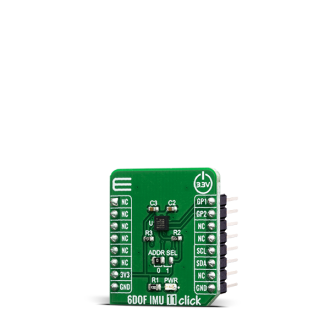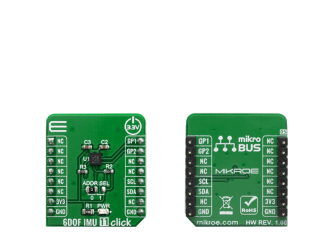
We strongly encourage users to use Package manager for sharing their code on Libstock website, because it boosts your efficiency and leaves the end user with no room for error. [more info]

Rating:
Author: MIKROE
Last Updated: 2019-12-02
Package Version: 1.0.0.0
mikroSDK Library: 1.0.0.0
Category: Motion
Downloaded: 3888 times
Not followed.
License: MIT license
The 6DOF IMU 11 click is a Click board based on the KMX63, a 6 Degrees-of-Freedom inertial sensor system on a single, silicon chip, which is designed to strike a balance between current consumption and noise performance with excellent bias stability over temperature.
Do you want to subscribe in order to receive notifications regarding "6DOF IMU 11 click" changes.
Do you want to unsubscribe in order to stop receiving notifications regarding "6DOF IMU 11 click" changes.
Do you want to report abuse regarding "6DOF IMU 11 click".


Library Description
The library covers all the necessary functions to control 6DOF IMU 11 click board. Library performs a standard I2C interface communication.
Key functions:
void c6dofimu11_set_default_sensor_config ( void ) - Set default sensor configuration function.void c6dofimu11_read_accel ( c6dofimu11_accel_t *accel_data ) - Get Accel range X, Y and Z value function.void c6dofimu11_read_mag ( c6dofimu11_mag_t *mag_data ) - Get Magnetometer magnetic field strength X, Y and Z value ( nT ) function.Examples description
The application is composed of three sections :
void application_task ( )
{
c6dofimu11_read_accel ( &accel_data );
Delay_ms( 10 );
c6dofimu11_read_mag ( &mag_data );
Delay_ms( 10 );
mikrobus_logWrite( " Accel X : ", _LOG_TEXT );
FloatToStr( accel_data.x, log_text );
c6dofimu11_uart_sign_print( );
mikrobus_logWrite( log_text, _LOG_TEXT );
mikrobus_logWrite( " g", _LOG_LINE );
mikrobus_logWrite( " Accel Y : ", _LOG_TEXT );
FloatToStr( accel_data.y, log_text );
c6dofimu11_uart_sign_print( );
mikrobus_logWrite( log_text, _LOG_TEXT );
mikrobus_logWrite( " g", _LOG_LINE );
mikrobus_logWrite( " Accel Z : ", _LOG_TEXT );
FloatToStr( accel_data.z, log_text );
c6dofimu11_uart_sign_print( );
mikrobus_logWrite( log_text, _LOG_TEXT );
mikrobus_logWrite( " g", _LOG_LINE );
mikrobus_logWrite( "- - - - - - - - - - - - - ", _LOG_LINE );
mikrobus_logWrite( " Mag X : ", _LOG_TEXT );
FloatToStr( mag_data.x, log_text );
c6dofimu11_uart_sign_print( );
mikrobus_logWrite( log_text, _LOG_TEXT );
mikrobus_logWrite( " uT", _LOG_LINE );
mikrobus_logWrite( " Mag Y : ", _LOG_TEXT );
FloatToStr( mag_data.y, log_text );
c6dofimu11_uart_sign_print( );
mikrobus_logWrite( log_text, _LOG_TEXT );
mikrobus_logWrite( " uT", _LOG_LINE );
mikrobus_logWrite( " Mag Z : ", _LOG_TEXT );
FloatToStr( mag_data.z, log_text );
c6dofimu11_uart_sign_print( );
mikrobus_logWrite( log_text, _LOG_TEXT );
mikrobus_logWrite( " uT", _LOG_LINE );
mikrobus_logWrite( "--------------------------", _LOG_LINE );
Delay_ms( 1000 );
}
Additional Functions :
void c6dofimu11_uart_sign_print ( ) - For beauty reasons in displaying the data log, this function inserts "+" sign when positive values have been read.Other mikroE Libraries used in the example:
Additional notes and informations
Depending on the development board you are using, you may need USB UART click, USB UART 2 click or RS232 click to connect to your PC, for development systems with no UART to USB interface available on the board. The terminal available in all MikroElektronika compilers, or any other terminal application of your choice, can be used to read the message.